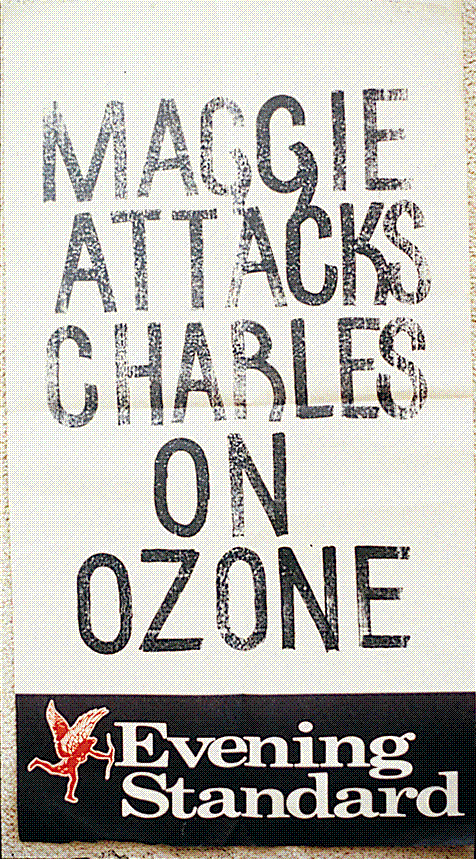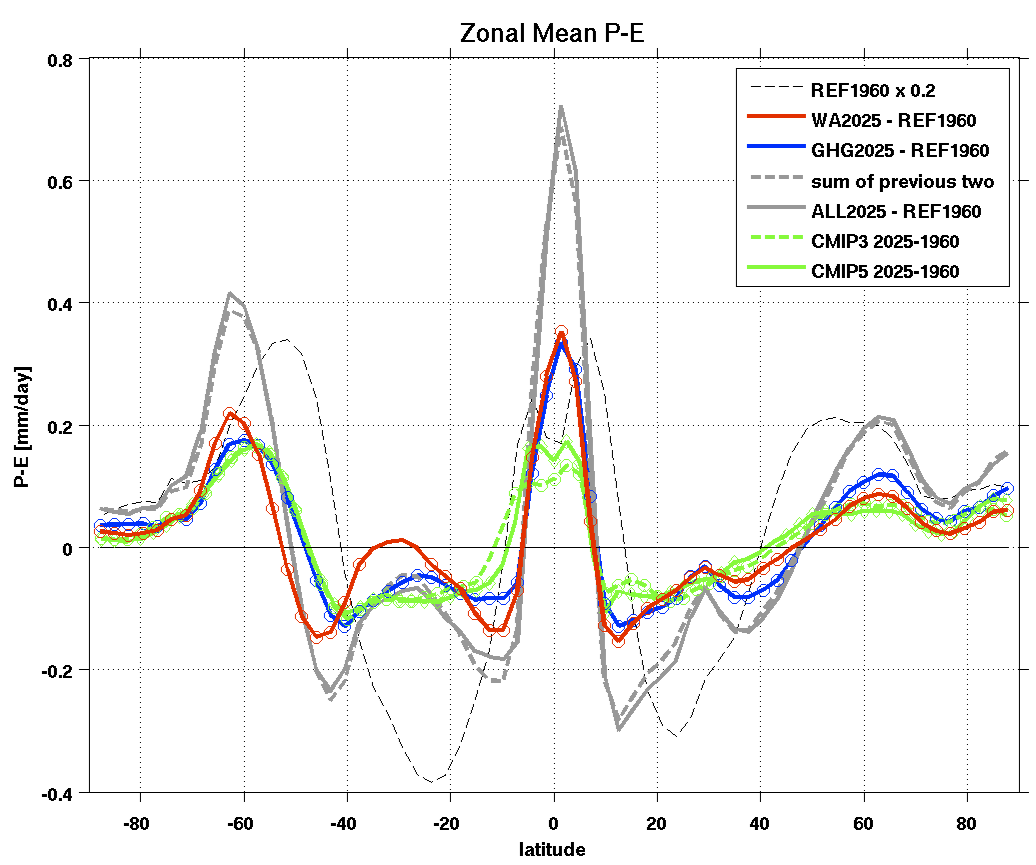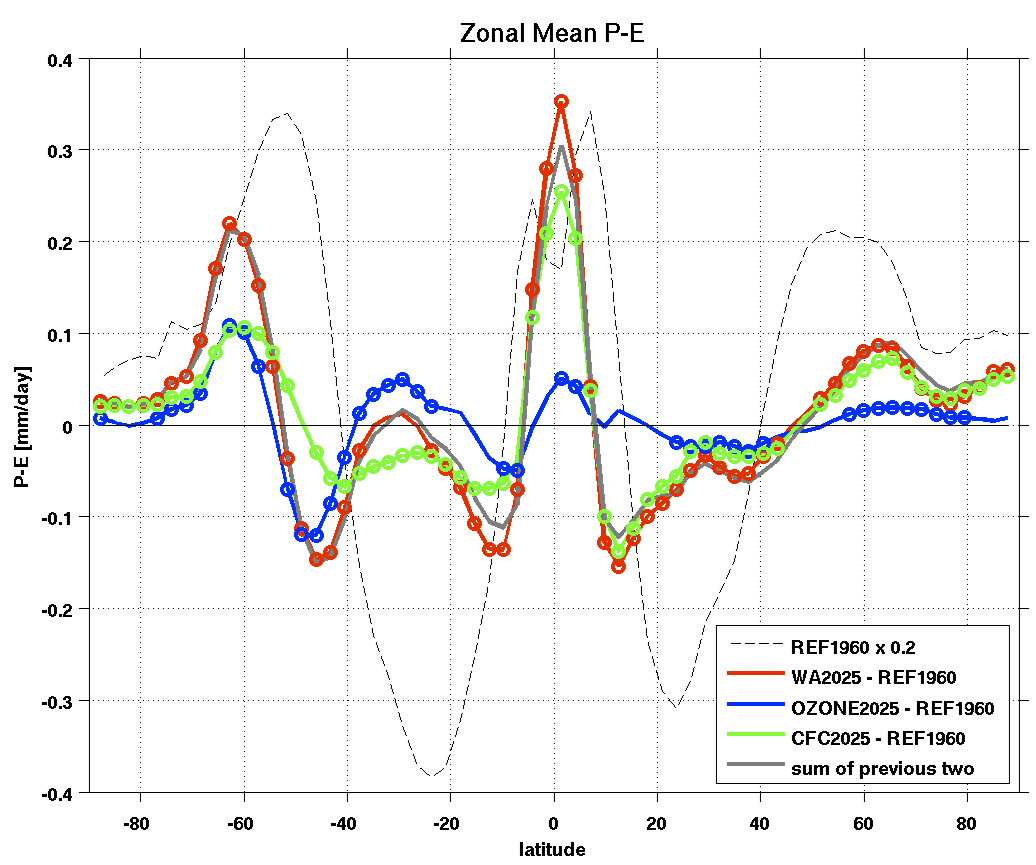|
Yutian Wu Lorenzo Polvani Richard Seager The 1987 Montreal Protocol was a triumph of international coordination and action to halt an ongoing environmental catastrophe. It phased out the use of CFCs and, hence, ended the depletion of the stratospheric ozone layer which is now showing signs of beginning to recover. The Montreal Protocol was motivated almost entirely by concern about the implications of diminished ozone allowing increased ultraviolet (UV) radiation to reach the surface and increase the risk of human skin cancers as well as physical damage to livestock, wildlife and plants. At the time the greenhouse warming potential of CFCs had been noticed but this was very much a secondary concern in development of the Protocol. 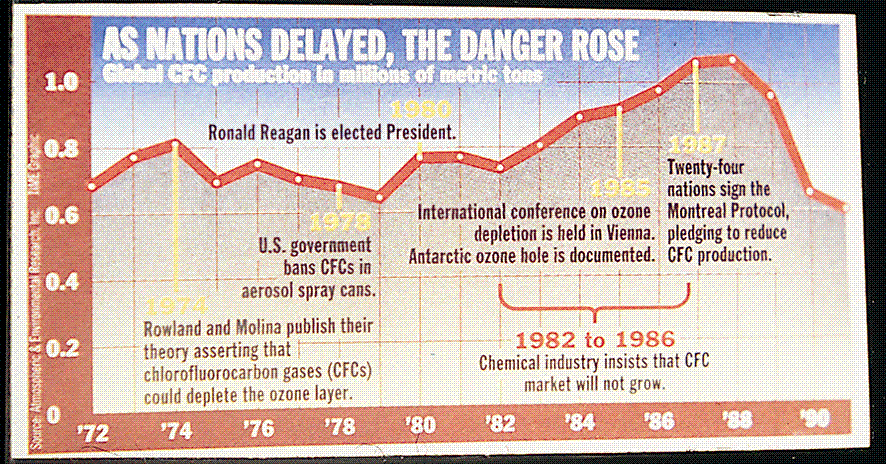 Since 1987 science has advanced considerably and we are learning that the Protocol is even more important than its designers realized back in the mid 1980s. First of all, modern climate-chemistry models indicate that the ozone loss accompanying continued CFC emissions would have been even worse than predictions in 1987 and, in fact, would have been catastrophic, affecting the whole planet early in the current century. Secondly, CFCs turn out to be highly potent greenhouse gases and the global warming avoided by their phase out is actually greater than that which the first implementation period of the Kyoto Treaty attempted to establish. Of course, despite the goals of Kyoto, emissions of carbon dioxide have increased with no international agreement to control them in sight. Hence it is hugely important that the Montreal Protocol is effectively protecting us against even more dangerous global warming and climate change. Unbeknownst to its designers, the Montreal Protocol turns out to be a climate protection treaty, even if an accidental one. Hydroclimate changes that the Montreal Protocol is preventing from occurring
Wu et al., 2013 show that the Montreal Protocol is also significantly protecting us from dangerous changes in the hydrological cycle. These are partly due to the the greenhouse warming caused by the CFCs but are also due to the impact that ozone depletion has on tropospheric circulation and, hence, on the locations and intensities of precipitation bands. Again, this is an effect of ozone depletion that negotiators of the Protocol were entirely unaware of in the 1980s. It has only been in the last decade or so that the impact of stratospheric circulation on winds in the troposphere and at the surface has been understood and it is only now, with work like this, that the implications for hydroclimate are beginning to be understood. To assess the hydroclimate protection afforded by the Montreal Protocol we conducted some atmosphere model simulations coupled to a simple mixed layer ocean. 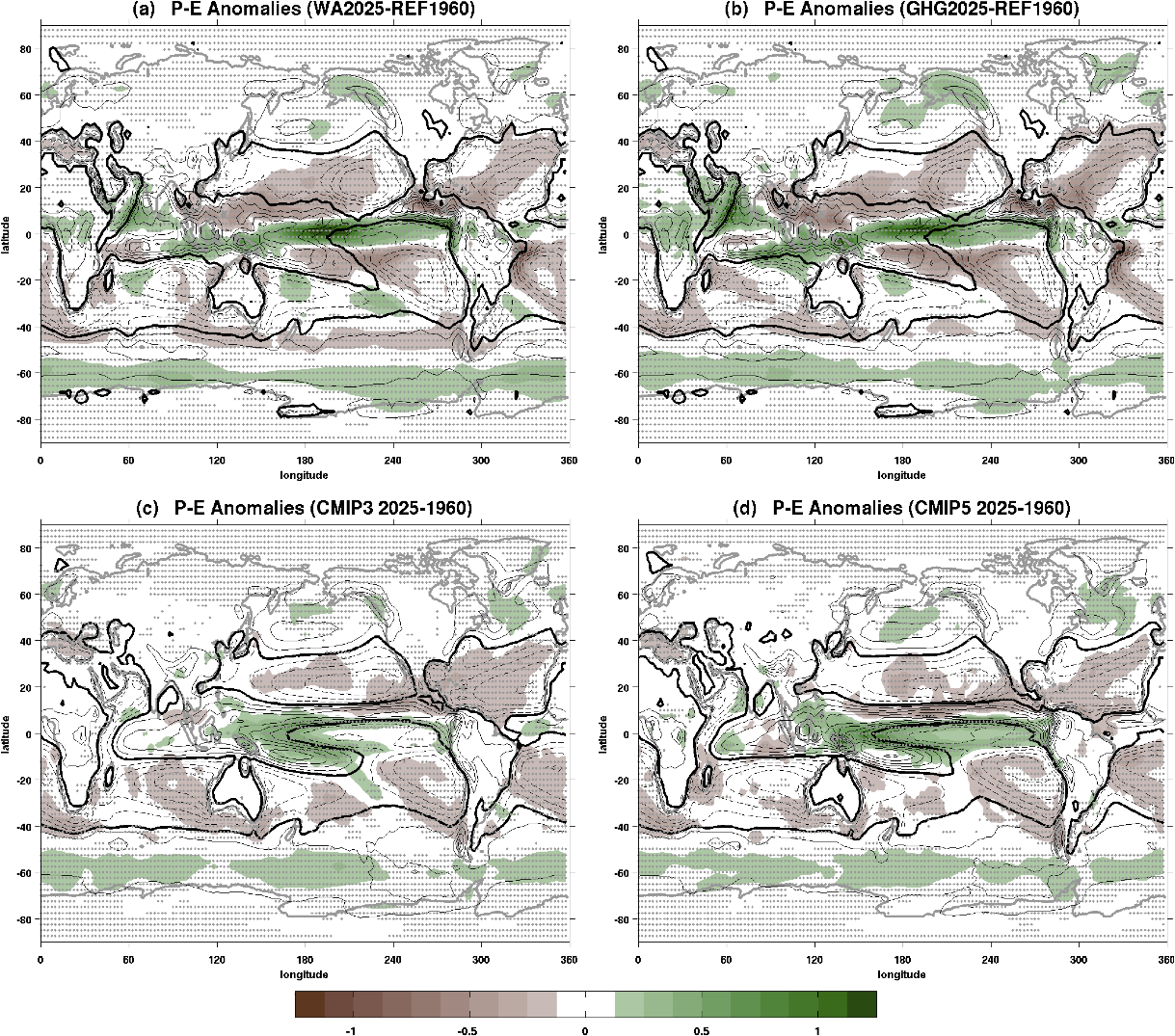
Figure 1. The basic result is shown in Figure 1 which shows maps of the difference in P-E for 2021-2030 and the 1960 decade for the case of CFC increase and ozone loss (top left), carbon dioxide, methane and nitrous oxide increase (top right), the change for projected actual changes in all radiative forcings from the IPCC AR4 models (bottom left) and the same for IPCC AR5 (bottom right). Figure 2 shows the zonal mean changes. Within our own model experiments, the change in P-E for the World Avoided and the increase in GHGs is very similar both in magnitude and pattern. By comparing these to the projections done as part of the IPCC process we can see that these are also in agreement with state--of-the art climate models. That is, the Montreal Protocol is protecting us from a hydroclimate change in the next decade that is equivalent in pattern and magnitude to that we actually expect to happen as a consequence of rising GHGs. Or, to put it another way, were it not for the Montreal Protocol, changes in hydroclimate in the next decade would be twice as large as we actually expect them to be.
Figure 2.
Mechanism of World Avoided hydroclimate change The changes of hydroclimate in the World Avoided are due to both the greenhouse effect of CFCs and the effect of ozone depletion. Figure 3 shows the changes in zonal mean P-E for the World Avoided case and for the two experiments with either CFC increase or ozone loss alone. For reference the model simulation of P-E in the 1960 control case is also shown. The effect of the CFC increase alone is the classic GHG-induced change to the hydroclimate with wet areas of the tropics and mid to high latitudes getting wetter and dry areas of the subtropics getting drier, a consequence of intensification of moisture transports in a warmer atmosphere that holds more moisture. The impact of ozone loss alone has some of these same characteristics in the northern hemisphere, though weaker, However, in the southern hemisphere the impact of ozone loss alone is more complex with two regions of wetting in the mid to high latitudes and the subtropics with a region of drying in-between and in the southern hemisphere tropics.
Figure 3. To better understand the impacts of the Montreal Protocol on hydroclimate we broke down the changes in the model atmospheric budget into thermodynamic components related to changes in atmospheric humidity and dynamic components related to changes in atmospheric circulation and changes in moisture transport by transient eddies. Results are in Figure 4. Ozone loss alone has little impact on tropospheric temperature and hence the changes in P-E are almost entirely due to changes in atmospheric circulation (the dynamic component). Ozone loss causes, via a tropospheric response to stratospheric circulation change, both a poleward shift in the jet streams and an increase in poleward moisture transport by transient eddies. For the case of CFC increase alone the atmosphere warms and the thermodynamic component is important causing wet areas to get wetter and dry areas to get drier. In addition the CFC increase causes large shifts in mean atmospheric circulation (as carbon dioxide increases do too) causing wetting at the Equator and drying in the northern tropics. Transient eddies also increase their poleward moisture transport in response to CFC increases. In general the amplitudes of the P-E changes due to ozone loss and CFC increases are the same and the total P-E change has to be explained as the result of both. 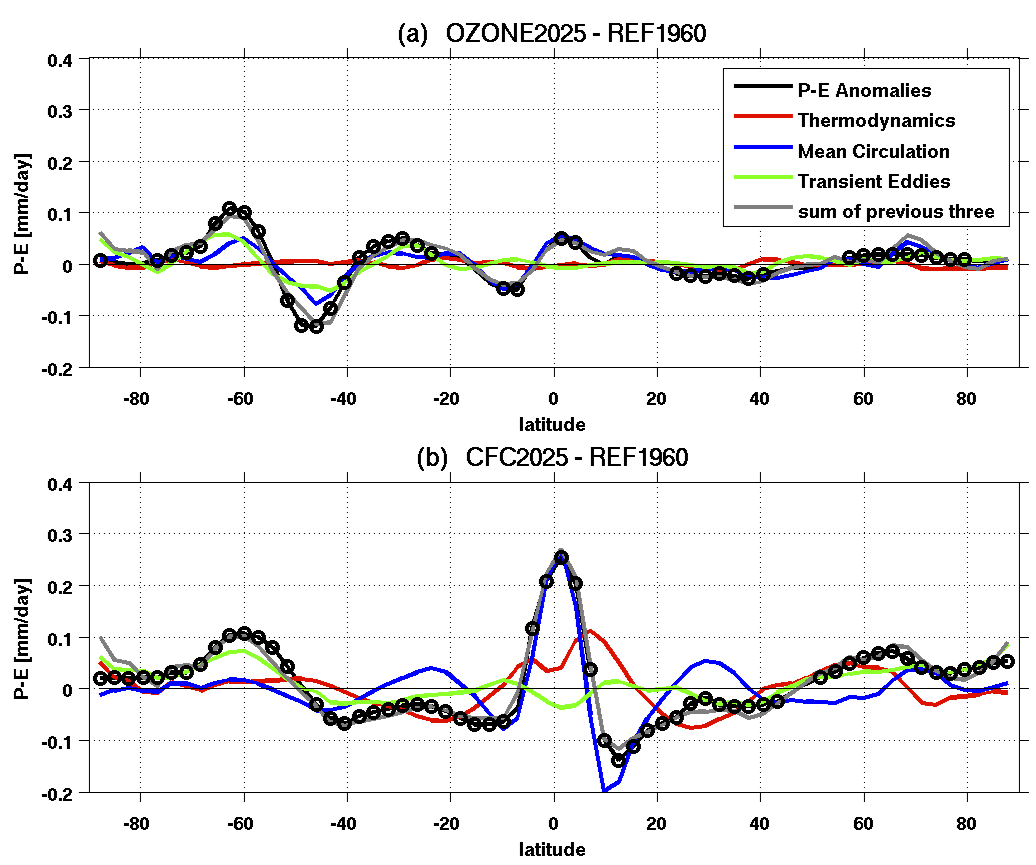
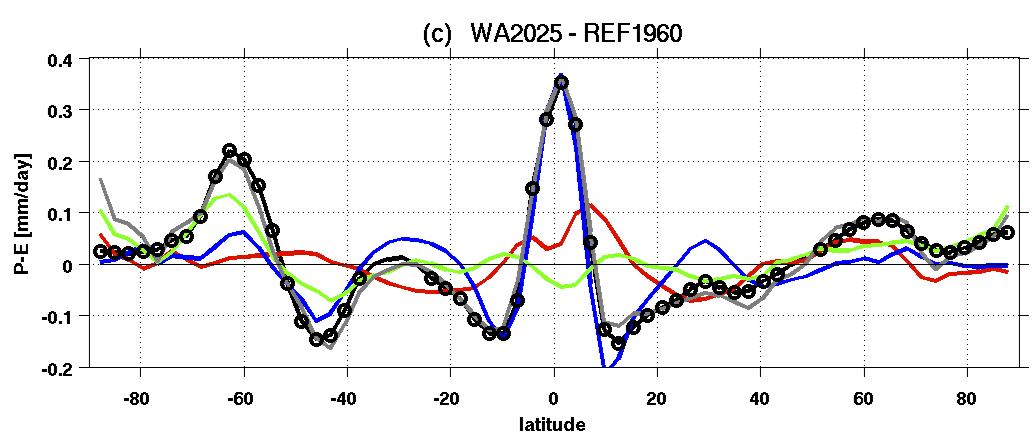
Figure 4. Conclusions: A climate protection treaty we can be proud of The 1987 Montreal Protocol and its Amendments have had a huge impact by preventing serious changes in the hydrological cycle. As such, changes in the coming decade will only be half as large as what they would have been without Montreal. This climate protection has been achieved purely by chance because the designers of the convention were barely aware of the climate impact of CFCs, knew little about the hydrological impacts of GHGs and knew nothing about the surface climate impacts of ozone loss. As such the world has a ratified, enforceable and working climate protection treaty (though it does not cover carbon dioxide and it should be noted that the replacements for CFCs are HFCs and some of those are strong GHGs). The creation and implementation of the Montreal Protocol is actually an inspiring story of scientists, politicians and environmental activists across globe working and successfully preventing, what we now know, would have been a multifaceted environmental catastrophe. It should be remembered that in the mid 1980s before Montreal the mechanisms of how CFCs destroy ozone was not fully understood and there was considerable argument over the role of CFCs and natural variability in explaining the observed ozone depletion. There was little data on how surface UV radiation was changing. Further there was considerable industry opposition to phasing out CFCs and no immediately available replacement as a coolant in refrigerators. There was also considerable international discord with developing nations saying a phase out would hold back their development. Amidst all this uncertainty and conflict, the creation and implementation of the Montreal Protocol is actually an inspiring story of scientists, politicians and environmental activists across the globe working and successfully preventing, what we now know, would have been a multifaceted environmental catastrophe. REFERENCES
|
